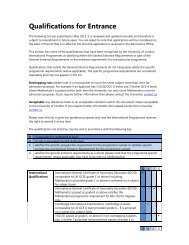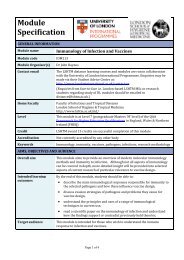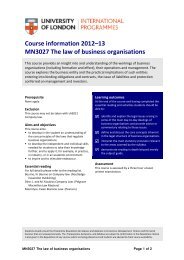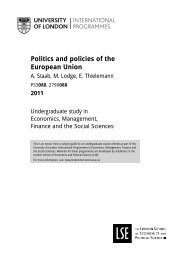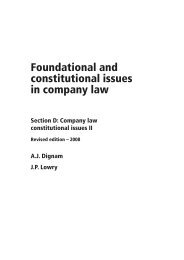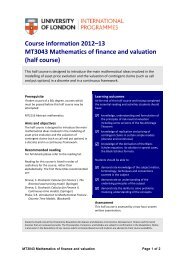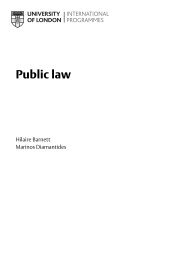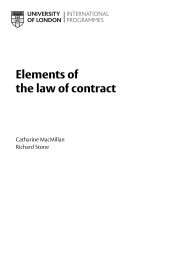Law and policy of international courts and tribunals - University of ...
Law and policy of international courts and tribunals - University of ...
Law and policy of international courts and tribunals - University of ...
Create successful ePaper yourself
Turn your PDF publications into a flip-book with our unique Google optimized e-Paper software.
<strong>Law</strong> <strong>and</strong> <strong>policy</strong> <strong>of</strong> <strong>international</strong> <strong>courts</strong> <strong>and</strong> <strong>tribunals</strong>: Section B<br />
their resolution. Treaties frequently refer to negotiation as the<br />
principal means <strong>of</strong> attempting to settle a dispute. For example, as<br />
noted in Chapter 1, Article 27 <strong>of</strong> the Convention on Biological<br />
Diversity provides that disputes between parties as to the<br />
interpretation or application <strong>of</strong> the Convention should be settled by<br />
negotiation, <strong>and</strong> that if agreement cannot be reached by<br />
negotiation the parties to the dispute may have resort to other<br />
peaceful means. Article 283 <strong>of</strong> the UN Convention on the <strong>Law</strong> <strong>of</strong><br />
the Sea (UNCLOS) provides that the parties to a dispute arising<br />
under UNCLOS should proceed expeditiously to an exchange <strong>of</strong><br />
views regarding settlement by negotiation or other peaceful means.<br />
The means through which negotiations are conducted are at the<br />
discretion <strong>of</strong> the parties to the dispute. They generally take place<br />
through diplomatic channels, but may also be conducted in the<br />
context <strong>of</strong> intergovernmental organisations or through specially<br />
convened summit meetings.<br />
Negotiations are not always directed at full settlement <strong>of</strong> every<br />
aspect <strong>of</strong> the dispute. They may be directed at different goals, for<br />
example:<br />
32<br />
the avoidance <strong>of</strong> a dispute (through prior consultations <strong>and</strong><br />
agreement)<br />
the management <strong>of</strong> an existing dispute (for example,<br />
negotiations to agree on an appropriate dispute settlement<br />
mechanism, or to define the parameters <strong>of</strong> the dispute)<br />
the implementation <strong>of</strong> a judgment or award.<br />
These possibilities are considered further below.<br />
3.2.1 Dispute avoidance<br />
Prior consultation <strong>and</strong> negotiation on an ad hoc or institutionalised<br />
basis can play an important role in preventing potential disputes.<br />
For example, <strong>international</strong> environmental law <strong>and</strong> the law <strong>of</strong><br />
<strong>international</strong> watercourses impose certain obligations upon states<br />
to consult with other potentially affected states before conducting<br />
certain activities on their own territory, where those activities affect<br />
or may affect other states. For example:<br />
In the 1957 Lac Lanoux arbitration, between France <strong>and</strong> Spain,<br />
the dispute concerned proposed activities <strong>of</strong> an upstream state<br />
affecting an <strong>international</strong> watercourse. The arbitral tribunal<br />
noted that the upstream state was entitled to exercise its rights,<br />
but could not ignore the interests <strong>of</strong> the downstream state,<br />
which was entitled to dem<strong>and</strong> that its rights be respected <strong>and</strong><br />
its interests taken into consideration. Accordingly, the<br />
upstream state had an obligation to consult the downstream<br />
state, <strong>and</strong> to take its interests into account, but the downstream<br />
state had no right <strong>of</strong> veto. This kind <strong>of</strong> obligation is now<br />
enshrined in the 1997 Convention on Non-Navigational Uses <strong>of</strong><br />
International Watercourses (not in force), <strong>and</strong> in numerous<br />
agreements related to specific <strong>international</strong> watercourses (i.e.<br />
rivers or lakes which form or cross national boundaries). They<br />
are also reflected in the International <strong>Law</strong> Commission’s 2001<br />
Draft Articles on the Prevention <strong>of</strong> Transboundary<br />
Environmental Harm, <strong>and</strong> in certain regional environmental<br />
agreements, such as the 1991 Espoo Convention on<br />
Environmental Impact Assessment in a Transboundary Context.




